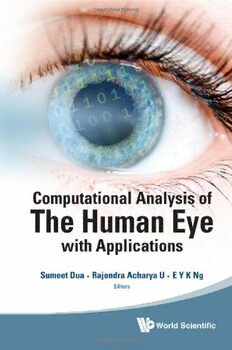
Computational Analysis of the Human Eye with Applications PDF
Preview Computational Analysis of the Human Eye with Applications
8074tp.indd 1 3/9/11 11:25 AM TThhiiss ppaaggee iinntteennttiioonnaallllyy lleefftt bbllaannkk Sumeet Dua Louisiana Tech University, USA Rajendra Acharya U Ngee Ann Polytechnic, Singapore E Y K Ng Nanyang Technological University, Singapore Editors World Scientific NEW JERSEY • LONDON • SINGAPORE • BEIJING • SHANGHAI • HONG KONG • TAIPEI • CHENNAI 8074tp.indd 2 3/9/11 11:25 AM Published by World Scientific Publishing Co. Pte. Ltd. 5 Toh Tuck Link, Singapore 596224 USA office: 27 Warren Street, Suite 401-402, Hackensack, NJ 07601 UK office: 57 Shelton Street, Covent Garden, London WC2H 9HE British Library Cataloguing-in-Publication Data A catalogue record for this book is available from the British Library. COMPUTATIONAL ANALYSIS OF THE HUMAN EYE WITH APPLICATIONS Copyright © 2011 by World Scientific Publishing Co. Pte. Ltd. All rights reserved. This book, or parts thereof, may not be reproduced in any form or by any means, electronic or mechanical, including photocopying, recording or any information storage and retrieval system now known or to be invented, without written permission from the Publisher. For photocopying of material in this volume, please pay a copying fee through the Copyright Clearance Center, Inc., 222 Rosewood Drive, Danvers, MA 01923, USA. In this case permission to photocopy is not required from the publisher. ISBN-13 978-981-4340-29-8 ISBN-10 981-4340-29-4 Typeset by Stallion Press Email: [email protected] Printed in Singapore. Sanjeed - Computational Analysis.pmd 1 5/9/2011, 3:27 PM March3,2011 15:16 9inx6in ComputationalAnalysisofHumanEyewithApplications b1055-fm Contents Chapter1. TheBiologicalandComputationalBasesofVision 001 HilaryW.Thompson Chapter 2. Computational Methods for Feature Detection inOpticalImages 039 MichaelDessauerandSumeetDua Chapter3. ComputationalDecisionSupportSystems andDiagnosticToolsinOphthalmology: ASchematicSurvey 089 SumeetDuaandMohitJain Chapter4. HyperspectralImageAnalysisforOxygen SaturationAutomatedLocalizationoftheEye 123 BahramKhoobehiandJamesM.Beach Chapter 5. Automated Localization of Eye and Cornea UsingSnakeandTarget-TracingFunction 187 Jen-HongTan,Ng,E.Y.K.,Rajendra Acharya,U.andChee,C. Chapter6. AutomaticDiagnosisofGlaucomaUsing DigitalFundusImages 207 RajendraAcharya,U.,OliverFaust,Zhu Kuanyi,TanMeiXiuIrene,BooMaggie,Sumeet Dua,TanJenHongandNg,E.Y.K. v March3,2011 15:16 9inx6in ComputationalAnalysisofHumanEyewithApplications b1055-fm Contents Chapter7. TemperatureDistributionInsidetheHumanEye withTumorGrowth 227 Ooi,E.H.andNg,E.Y.K. Chapter8. TheStudyofOcularSurfaceTemperature byInfraredThermography:ThePrinciples, Methodologies,andApplications 265 Jen-HongTan,Ng,E.Y.K.,Rajendra Acharya,U.andChee,C. Chapter9. AutomatedMicroaneurysmDetection inFluoresceinAngiogramsforDiabetic Retinopathy 279 PrernaSethiandHilaryW.Thompson Chapter10. Computer-AidedDiagnosisofDiabetic RetinopathyStagesUsingDigital FundusImages 301 Rajendra Acharya, U., Oliver Faust, Sumeet Dua,SeahJiaHong,TanSweeYang,PuiSan LaiandKityeeChoo Chapter11. ReliableTransmissionofRetinalFundus ImageswithPatientInformationUsing Encryption,Watermarking,andError ControlCodes 319 Myagmarbayar Nergui, Sripati Acharya, U., RajendraAcharya,U.,WenweiYu andSumeetDua Chapter 12. Temperature Changes Inside the Human Eye DuringLTKP 349 Ooi,E.H.andNg,E.Y.K. vi March3,2011 15:16 9inx6in ComputationalAnalysisofHumanEyewithApplications b1055-fm Contents Chapter13. OpticalEyeModelingandApplications 381 Ying-LingChen,BoTan,LeiShi,Lewis,J.W.L. andMingWang Chapter14. AutomatingtheDiagnosis,Stratification,and Management of Diabetic Retinopathy Using Content-Based Image Retrieval in an Ocular TelehealthNetwork 417 ThomasP.Karnowski,LucaGiancardo,Deniz Aykac, Kenneth W. Tobin, Yaqin Li, Seema Garg,MichaelD.Abramoff,MatthewT. Tennant,andEdwardChaum Index 455 vii TThhiiss ppaaggee iinntteennttiioonnaallllyy lleefftt bbllaannkk March3,2011 10:27 9inx6in ComputationalAnalysisofHumanEyewithApplications b1055-ch01 Chapter 1 The Biological and Computational Bases of Vision ∗ HilaryW. Thompson 1.1. IntroductiontotheEye Thehumanvisualsystem,fromphotoreceptorstohigher-orderprocessing of signals in the brain, is a remarkable example of the power of evolu- tionaryprocessesactingovervastperiodstodevelopafinelytunedsystem capable of complex recognition, recall, and execution of highly accurate tasksinspaceandtime.Intermsofgenetics,physiology,andstructure,the evolutionary pathway to higher vertebrate vision can be traced.1 In fact, it has been hypothesized that the development of a complex visual sys- tem preceded and provided the evolutionary substrate for the evolution of brainexpansionthatmadepossiblehighercognitivefunctionsinprimates.2 Vertebrate vision is one of the most profound and illuminating examples illustratingtheoperationofevolutionaryprinciples.3 From using chipped stones to the technology of spacecraft and global computernetworks,humanshavereliedontheexceptionalpowersofvision to survive, prosper in, predict, and, to some degree, control and reshape an often-challenging environment. The primacy of vision in the human experienceisevidencedinourlanguage:to“see”alsomeanstounderstand, as does “to have the eyes opened.” Such definitions occur, not only in the English language, but also in the metaphors and figures of the speech of other languages as well. Humans are visual animals, and the loss of sight ∗ LSUEyeCenter,LSUHSCSchoolofPublicHealth,DepartmentofOphthalmology,NewOrleans,LA. 1
